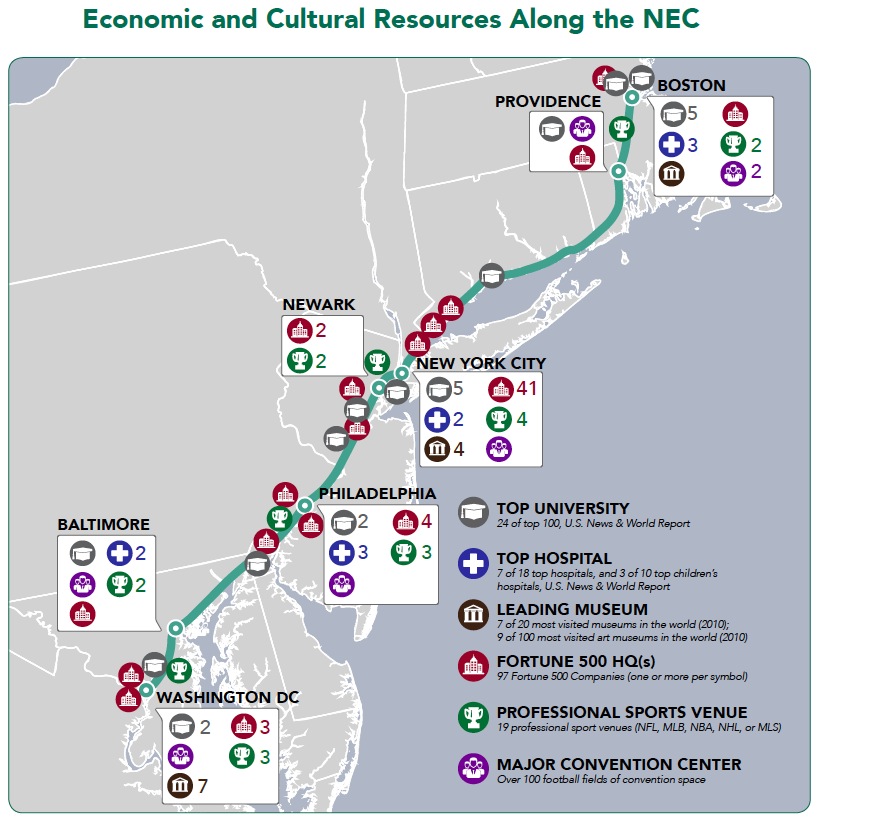NORTHEAST CORRIDOR INFRASTRUCTURE AND OPERATIONS COMMISSION
Executive Summary
Report Purpose
The Northeast Corridor and the American Economy responds to a Congressional mandate established in the Passenger Rail Investment and Improvement Act of 2008, commonly referred to as PRIIA, which calls upon the Northeast Corridor Infrastructure and Operations Advisory Commission (the NEC Commission) to submit a report to Congress on the role of the NEC in supporting economic activity and opportunities for the NEC to enhance economic development.
The Northeast Corridor Rail Network
The Northeast Corridor (NEC) rail network between Washington, D.C. and Boston, Massachusetts is an engine of economic activity for the United States in the delivery of workers to jobs, businesses to clients, goods to market, and people to their friends, family, and leisure activities. Its commuter rail and Amtrak intercity services move 750,000 people each day. Daily NEC users contribute more than $50 billion annually to the national economy.
The NEC is a shared resource, used by eight commuter rail operators, Amtrak, and four freight railroads. It connects eight states and the District of Columbia, but its impacts extend across the country. An unexpected loss of the NEC for one day alone could cost the nation nearly $100 million in transportation-related impacts and productivity losses, roughly the daily economic output of cities like Winston-Salem, North Carolina, Portland, Maine, or Boulder, Colorado.
The Northeast Corridor Region and Economy
The NEC Region is home to more than 51 million people and four of the ten largest metropolitan areas in the country. The NEC connects interdependent markets that collectively are a national and global force. Its economy is the fifth largest in the world, ahead of France and just behind Germany. The NEC Region is an international center for education, healthcare, technology, media, and finance, all industries widely expected to fuel economic growth in the 21st century. Research in this report finds that the NEC contributes to the productivity and livability of the Region in ways that increase the nation’s global competitiveness.
The Northeast Corridor – An Engine of Economic Activity
Seven million jobs are within five miles of an NEC station, about a third of all jobs in the NEC Region. The NEC expands the number of communities within reasonable commuting distance of these job centers with rail service that is often faster and more reliable over longer distances than automobile. Increased job accessibility helps businesses by growing their pool of talented workers. Increased job accessibility also allows families to choose from more communities in terms of affordability and lifestyle preferences, while maintaining access to the jobs, educational institutions, cultural attractions, and major event centers in the NEC Region’s core cities.
Amtrak intercity service plays a central role in traditional business and leisure travel, but also supports job accessibility in an era when more employers are becoming supportive of arrangements that combine travel with remote work, especially in the case of dual-career households.
In addition to supporting $50 billion in annual U.S. productivity, the NEC’s impact on the American economy is felt in the national aviation system. Though more than half of flight delays nationwide originate at New York and Philadelphia area airports, Amtrak relieves this pressure by carrying more passengers for trips within the NEC Region than all airlines combined. The NEC also connects the national freight rail network to east coast ports, thereby connecting manufacturing plants in states like Illinois, Indiana, Iowa, Kansas, Michigan, Nebraska, and North Dakota to international customers.
Download full version (PDF): The Northeast Corridor and the American Economy
About the Northeast Corridor Infrastructure and Operations Commission
www.nec-commission.com
Congress created the Northeast Corridor Infrastructure and Operations Advisory Commission in recognition of the inherent challenges of coordinating, financing, and implementing major system improvements that cross multiple jurisdictions. The Commission is comprised of members from each of the Northeast Corridor states, Amtrak, and the U.S. Department of Transportation and includes non-voting representatives from freight railroads and states with connecting corridors. The expectation is that by coming together to take collective responsibility for the Northeast Corridor, these disparate stakeholders will achieve a level of success that far exceeds the potential reach of any individual organization.
Tags: Connecticut, CT, NEC, New Jersey, New York, NJ, Northeast Corridor, Northeast Corridor Infrastructure and Operations Commission, NY







 RSS Feed
RSS Feed